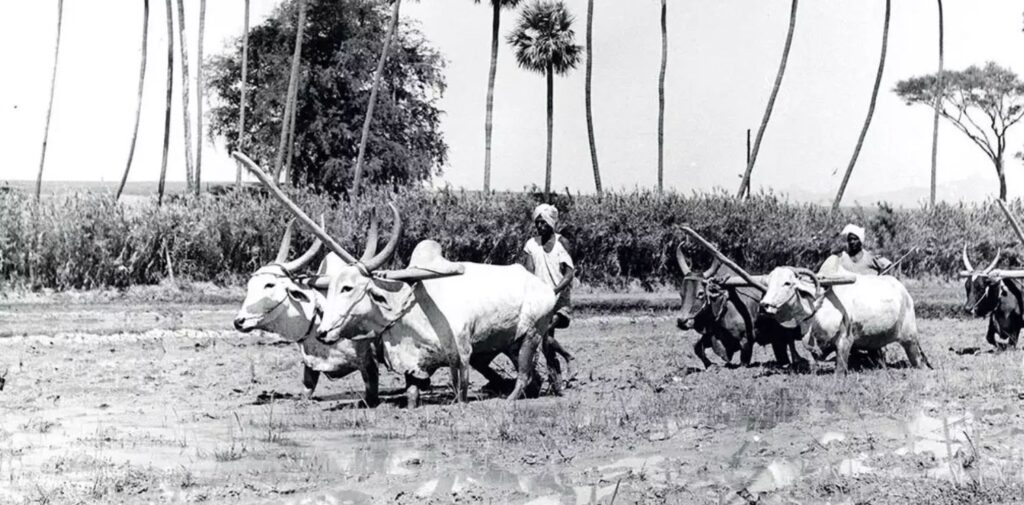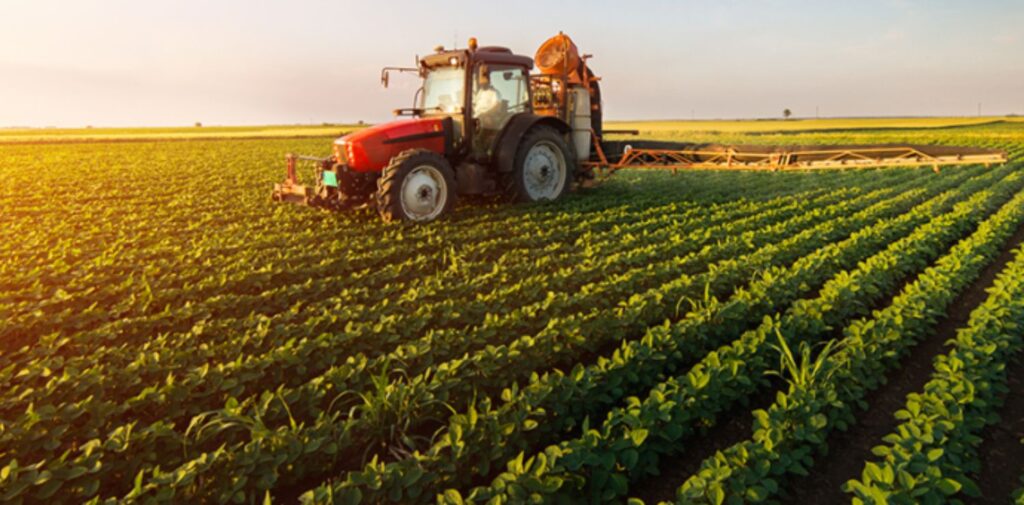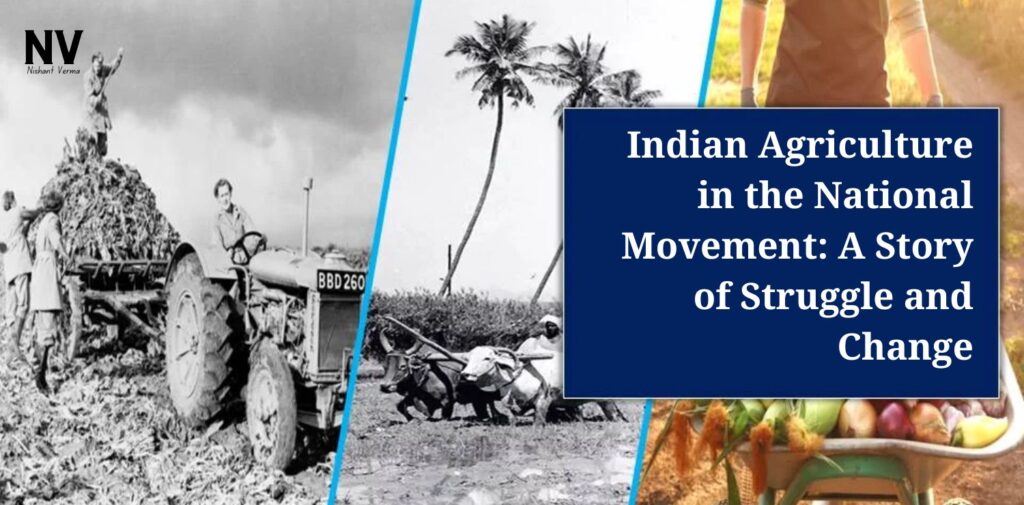Agriculture has always been the backbone of India’s economy and culture. The vast majority of Indians, especially during the colonial era, were involved in farming. It is no surprise that the national movement for independence, which aimed to free India from British rule, was deeply connected to agricultural issues. The British colonial policies greatly affected Indian farmers, leading to their exploitation. As the freedom struggle grew stronger, agriculture became an essential issue that leaders and common people alike fought for.
This article explores about Indian Agriculture in the National Movement, highlighting its challenges and the role it played in shaping India’s path to freedom.
The Condition of Agriculture Before the National Movement
Before the British arrived in India, agriculture was a significant part of the Indian economy. Most of the population was dependent on farming for their livelihood. India was known for its rich soil, and agriculture thrived in different regions. However, under British rule, the situation started to change drastically.
The British government introduced several policies that hurt Indian farmers:
- Heavy Taxes: The British imposed high taxes on crops, land, and farmers. These taxes were often collected in cash, not in kind, making it hard for farmers to pay.
- Land Revenue System: The introduction of the Permanent Settlement Act in 1793 fixed land revenues, which were often too high for the peasants to pay. If farmers could not pay, they lost their land.
- Commercialization of Agriculture: The British forced Indian farmers to grow cash crops such as cotton, indigo, and opium instead of food crops. This led to food scarcity in the country and increased suffering.
- Economic Exploitation: The British introduced systems that took away the wealth from India. India’s agricultural products were exported to Britain, leaving farmers poor and dependent on a system that benefitted the colonial rulers.
The exploitation of farmers during this time laid the foundation for the agricultural problems that became a central issue in the National Movement.

How Agriculture Became Part of the National Movement
The early phase of the National Movement mainly focused on constitutional reforms and political rights. However, as the movement progressed, issues like poverty, land reforms, and farmer exploitation started gaining attention. Leaders of the freedom struggle realized that India’s freedom from British colonial rule was incomplete without addressing the problems of the rural economy and agriculture.
- The Role of Leaders: Many leaders in the National Movement, including Mahatma Gandhi, Jawaharlal Nehru, and Subhas Chandra Bose, understood that the success of the struggle for freedom was closely linked to the condition of Indian agriculture. They realized that the economic policies of the British were destroying the very foundation of India’s rural society. Therefore, agricultural reforms became a vital part of their fight.
- Gandhi’s Focus on Rural India: Mahatma Gandhi, the leader of the Indian independence movement, gave significant attention to the rural economy. He believed that India’s future depended on empowering the villages and farmers. Gandhi’s emphasis on Swaraj (self-rule) extended to agricultural reforms. He saw self-sufficiency in agriculture as a key aspect of India’s independence and resistance to colonial exploitation.
- The Champaran and Kheda Movements: Gandhi’s early involvement with agricultural struggles started with the Champaran Satyagraha in 1917. The peasants in Champaran (now in Bihar) were forced to grow indigo under harsh conditions for the British. Gandhi helped them organize against this injustice, leading to a significant victory for the farmers. This success made Gandhi more aware of the problems faced by the rural poor and inspired him to fight for their rights in future movements. Similarly, the Kheda Satyagraha in Gujarat (1918), where farmers were suffering due to high taxes during a famine, became another pivotal moment in the National Movement focused on agricultural rights.
- The Role of the Congress: The Indian National Congress (INC) increasingly began to address agricultural issues. During the Non-Cooperation Movement (1920–1922), the Congress included the demand for fair treatment of farmers as part of its agenda. Farmers from all parts of India began to organize themselves, forming associations to demand lower taxes, better prices for their produce, and relief from unjust policies.

The Economic Impact of Agriculture on the National Movement
The condition of Indian agriculture not only caused social and economic distress but also had a profound political impact. Farmers and the rural population were disillusioned with the British, and this made them a significant part of the freedom struggle.
- Peasant Revolts and Agitation: The exploitation of farmers led to several revolts, uprisings, and protests against British rule. These movements were closely tied to agricultural issues. The rebellion of the indigo farmers in Bengal (1859-1860), the Deccan riots, and the Uprising of 1857 had agricultural roots. The anger among the farmers was often directed towards the oppressive policies of the British, especially the land revenue systems and unfair taxation.
- The Role of the Peasantry in Freedom Movements: As the national movement grew, the support of the rural population became more critical. Farmers, along with workers and other sections of society, were encouraged to join the freedom struggle, which they did in large numbers. The Gandhian method of non-violence and non-cooperation resonated well with the rural communities, especially because of the direct connection between their daily hardships and the British policies.
- The Economic Boycott: The struggle for a boycott of British goods was extended to the agricultural sector. Cotton, indigo, and other crops were used for export, but Gandhi promoted the idea of self-sufficiency and indigenous production of goods. The Swadeshi Movement, which called for the boycott of foreign goods, had a significant impact on farmers, urging them to reduce their dependence on imported products and focus on local production and self-reliance.

Agricultural Reforms Post-Independence
After India gained independence in 1947, agriculture continued to be a key focus of the new government. The influence of the National Movement in highlighting agricultural issues was reflected in the policies of the newly independent nation.
- Land Reforms: After independence, one of the first tasks was land reform. The government implemented measures like land redistribution, which aimed to break the hold of landlords over the land. The goal was to provide land to the landless and reduce the exploitation that farmers had faced under the British.
- Green Revolution: In the 1960s and 1970s, India introduced the Green Revolution, which introduced high-yielding varieties of crops, fertilizers, and irrigation techniques. While this led to increased agricultural production, it also created new challenges like environmental degradation and unequal distribution of benefits. Nevertheless, it marked a significant shift towards modernizing Indian agriculture.
Conclusion: Indian Agriculture in the National Movement
Agriculture was not just an economic issue for India’s farmers; it was at the heart of the struggle for independence. The exploitation of the peasantry by the British Empire was one of the driving forces behind India’s National Movement. Leaders like Mahatma Gandhi understood the importance of the agricultural sector and its role in shaping India’s future. They fought for a just system where farmers could live with dignity and have control over their land.
As we look back at India’s struggle for independence, it is clear that agriculture played a crucial role in mobilizing the masses, inspiring protests, and shaping the policies of the future. The lessons from the past continue to guide India in its ongoing quest for agricultural reforms and rural development. Even today, agriculture remains a central pillar of the Indian economy, and its progress is key to the nation’s prosperity.




